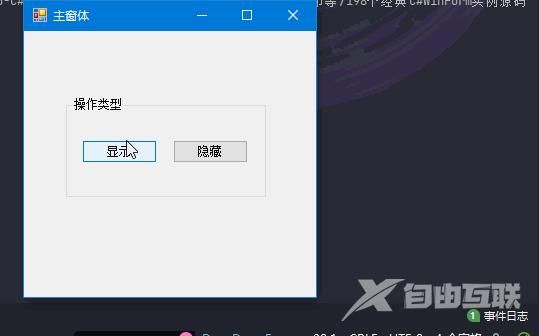目录 实践过程 效果 代码 实践过程 效果 代码 public partial class GroundForm : Form { public GroundForm() { InitializeComponent(); } private void display_Click(object sender, EventArgs e) { DropDownForm.Instance().ShowForm()
目录
- 实践过程
- 效果
- 代码
实践过程
效果

代码
public partial class GroundForm : Form
{
public GroundForm()
{
InitializeComponent();
}
private void display_Click(object sender, EventArgs e)
{
DropDownForm.Instance().ShowForm(); //显示窗体
}
private void close_Click(object sender, EventArgs e)
{
DropDownForm.Instance().CloseForm(); //隐藏窗体
//关闭窗体
this.Close();
}
}
public partial class DropDownForm : System.Windows.Forms.Form
{
#region 声明的变量
private System.Drawing.Rectangle Rect; //定义一个存储矩形框的数组
private FormState InfoStyle = FormState.Hide; //定义变量为隐藏
static private DropDownForm dropDownForm = new DropDownForm(); //实例化当前窗体
private static int AW_HIDE = 0x00010000;
private static int AW_SLIDE = 0x00040000;
private static int AW_VER_NEGATIVE = 0x00000008;
#endregion
#region 该窗体的构造方法
public DropDownForm()
{
InitializeComponent();
//初始化工作区大小
System.Drawing.Rectangle rect = System.Windows.Forms.Screen.GetWorkingArea(this);
this.Rect = new System.Drawing.Rectangle(rect.Right - this.Width - 1, rect.Bottom - this.Height - 1,
this.Width, this.Height);
}
#endregion
#region 调用API函数显示窗体
[DllImportAttribute("user32.dll")]
private static extern bool AnimateWindow(IntPtr hwnd, int dwTime, int dwFlags);
#endregion
#region 鼠标控制图片的变化
private void pictureBox1_MouseEnter(object sender, EventArgs e)
{
for (int i = 0; i < imageList1.Images.Count; i++)
{
if (i == 1)
pictureBox1.Image = imageList1.Images[i];
}
}
private void pictureBox1_MouseLeave(object sender, EventArgs e)
{
for (int i = 0; i < imageList1.Images.Count; i++)
{
if (i == 0)
pictureBox1.Image = imageList1.Images[i];
}
}
#endregion
#region 定义标识窗体移动状态的枚举值
protected enum FormState
{
//隐藏窗体
Hide = 0,
//显示窗体
Display = 1,
//显示窗体中
Displaying = 2,
//隐藏窗体中
Hiding = 3
}
#endregion
#region 用属性标识当前状态
protected FormState FormNowState
{
get { return this.InfoStyle; }
set { this.InfoStyle = value; }
}
#endregion
#region 显示窗体
public void ShowForm()
{
switch (this.FormNowState)
{
case FormState.Hide:
if (this.Height <= this.Rect.Height - 192) //当窗体没有完全显示时
this.SetBounds(Rect.X, this.Top - 192, Rect.Width, this.Height + 192); //使窗体不断上移
else
{
this.SetBounds(Rect.X, Rect.Y, Rect.Width, Rect.Height); //设置当前窗体的边界
this.FormNowState = FormState.Display; //设置当前窗体的操作状态为显示
}
AnimateWindow(this.Handle, 800, AW_SLIDE + AW_VER_NEGATIVE); //动态显示本窗体
break;
}
}
#endregion
#region 关闭窗体
public void CloseForm()
{
switch (this.FormNowState)
{
case FormState.Display: //显示当前窗体
if (this.Top <= this.Rect.Bottom - 192) //如果窗体没有完全隐藏
{
this.SetBounds(Rect.X, this.Top + 192, Rect.Width, this.Height - 192); //使窗体不断下移
}
else
{
this.Close(); //隐藏当前窗体
this.FormNowState = FormState.Hide; //设置窗体的操作状态为隐藏
}
break;
}
}
#endregion
#region 返回当前窗体的实例化对象
static public DropDownForm Instance()
{
return dropDownForm;
}
#endregion
#region 在窗体的关闭事件中进行动态关闭
private void DropDownForm_FormClosing(object sender, FormClosingEventArgs e)
{
e.Cancel = true;
AnimateWindow(this.Handle, 800, AW_SLIDE + AW_VER_NEGATIVE + AW_HIDE);
this.Close();
}
#endregion
}
以上就是C#实现系统桌面右下角弹框的详细内容,更多关于C#桌面弹框的资料请关注自由互联其它相关文章!
